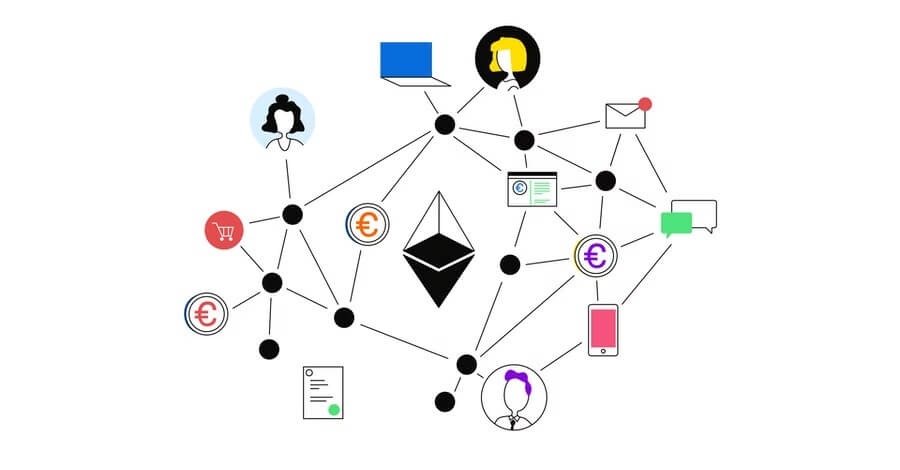Ethereum Explained
To understand Ethereum, you first need to know how the internet works today.
At the moment, when you give your personal information (like your name and address) to a company online, that information is stored on their computer system (called a server).
Think about all your information that is stored on hundreds of different company and government servers. Your name, phone numbers, bank balances, credit card records, text messages, emails, medical records, and even your photos. The list is endless!
All around you there is a huge, invisible network of computer servers, filled to the brim with all of our information.
Most of these computer systems are operated by big technology companies like Microsoft and Google, which run them on behalf of the companies you do business with.
This current way of doing things is convenient, but it has two big downsides. First, there are high fees for running these systems, which are passed on to you. Second, your personal information in these systems is vulnerable to hacking.
Hacking happens all the time, because each server acts like a big target that’s packed full of valuable customer information. All companies face this issue. They are in a never-ending race with hackers.
Recent examples of big hacks that resulted in lots of stolen customer information include Dropbox, Walmart, Starbucks, Facebook, Uber, Equifax, and Google. As you can see, even the biggest companies can’t protect themselves against hacking forever.
In 2013, programmer Vitalik Buterin and others created a new technology called Ethereum to change how the internet works.
Ethereum is revolutionary because, for the first time, it allows online computer systems to run without using ANY third party (like Google).
Not needing a third party (like Google) to store and transfer information has a lot of benefits. Without middlemen, computer systems become cheaper to run and also harder to shut down.
Plus, your personal information can become more private because companies no longer store it (forever) on their servers. You’re probably beginning to see why Ethereum is such a game changer.
What is Ethereum?
Instead of using the computer system of a big company like Google (a centralized system), Ethereum lets software applications run on a network of many private computers (a decentralized system).
Company computers and cloud servers are replaced with a large, decentralized network of many small computers that are run by volunteers from all around the world.
Scroll through any app store and you will see a long list of applications that rely on big companies to run them and to store your information. From banking to health to games – all these apps use big, central servers.
Moreover, even your choice of apps is controlled by third parties like Apple and Google. If these companies don’t like an app, it won’t be allowed in their app stores.
Ethereum is doing the opposite: It wants to remove third parties from how you access and use applications. In short, it puts the community of users in charge!
The big idea behind Ethereum is that anybody can use this new, decentralized network to create and run decentralized applications. No permission is needed because third parties are no longer required.
Think of Ethereum as a technology platform that allows anybody to run applications on its global network.
Because these applications no longer use a central server, they are known as decentralized applications (or dapps). In other words, no central authority is needed to create and run them.
Incredibly, Ethereum is not controlled by Vitalik and his team - or any other person, company, or government. It’s run by the community of its users. Read that twice, because it’s important!
Ethereum users are located all around the world and volunteer their computers to help run the Ethereum network. Information on this network is sent directly from person to person, instead of from person to company to person. This is known as a peer-to-peer system (P2P). It means there is no central control.
What’s amazing is that none of the users in the Ethereum community need to know each other for this system to work. You can use the Ethereum system online without needing to meet or even trust any other person. We’ll explain how that’s possible below.
Ethereum’s vision is to create a “World Computer” – a huge network of many private computers that run all future internet applications without any third parties (like Google and Microsoft).
Ethereum is reinventing how the internet works. It’s removing power and control from big tech companies and is putting them into your hands.
Removing third parties has many benefits. For example: since Ethereum is a computer network run by the community of its users, your personal information is no longer stored on the central servers of big companies, waiting to be hacked, sold, and disrupted.
Decentralization also means that nobody can be excluded from using Ethereum applications. People from all countries and backgrounds can use them without approval or permission.
Even the Ethereum applications themselves don’t need permission to exist. They cannot be removed or censored from any app store. It’s an open system and anybody with an internet connection is welcome!
How Does Ethereum Work?
Imagine two people sending each other messages on their smartphones.
Traditionally, the two would use messaging apps like WhatsApp, Facebook, or Skype, which are run by large companies. Once sent, the message actually goes from the sender to a company server and only then to the receiver.
Because companies control traditional messaging apps, they also control and store all messages that are being sent, plus any other personal information, like the photos you attach. All that gets stored forever.
This can become a problem if company servers are hacked, if services are discontinued, or if companies sell your information to marketers.
Now, imagine the two people are using a decentralized Ethereum messaging app instead.
The Ethereum system is not run by a company, but by a network of independent, private computers from around the world.
When somebody hits “Send,” the message goes from the sender to the Ethereum network and from there to the receiver. The best part is that your message is hidden from the network.
Even though Ethereum uses a global, public network of computers, only the sender and receiver can see their messages. The information that is being sent is hidden from everybody else through strong computer code (encryption). Additionally, the message never gets stored on company servers in the middle.
The two people sending messages would not notice any difference between the traditional, centralized apps and the new, decentralized apps. From their perspective, the Ethereum app works exactly like a traditional messaging app.
Decentralized apps work automatically, without any middlemen, because they use Smart Contracts.
Smart Contracts put agreed-upon rules into computer code and then enforce them automatically.
They work like a vending machine, which is programmed to enforce rules automatically: You put in $0.50? No soda. You put in $1? Soda! You put in $1 but the soda is sold out? Refund.
The best part is that after the rules are agreed upon, nobody can change or manipulate them – ensuring fairness to all parties. Smart Contracts automatically decide who gets paid under what conditions and how disputes are resolved. They run on their own!
Imagine tickets for a baseball game being sold using Ethereum Smart Contracts.
Since the contract is “smart” it can automatically act based on certain events.
For example, the Smart Contract could be connected to a weather app and be programmed to automatically issue refunds if it rains on game day. Pretty magical, isn’t it?
What’s special about Smart Contracts is that none of the participants have to trust each other.
After the rules of a Smart Contract are agreed upon and the Contract is live, nobody can change those rules to cheat. The Smart Contract acts on its own and does exactly what it’s programmed to do, no matter what. For example, the stadium owner can’t change his mind and cancel the refunds.
Without interference being possible, all participants can trust the Smart Contract, even though they may not trust each other.
Many Ethereum applications and Smart Contracts require an exchange of money. Because Ethereum is completely digital, it needs a built-in digital payment method to do that.
In the Ethereum system, all payments are made using its own digital currency, called Ether.
Here is how the Ethereum platform and Ether currency work together: Every time money is transferred by an Ethereum Smart Contract, Ether is used for that transaction.
Unlike traditional currencies like the U.S. Dollar, Ether is 100% digital. Because of that, it can be “stored” directly in the Smart Contract’s code. This makes it possible for the Smart Contract to automatically send and receive money.
In addition to Smart Contracts, Ether is also used to pay all the volunteers who help to run the decentralized Ethereum system with their computers. Each participant receives Ether, since they pay electricity and use their hardware to help run the system.
Ether also has an important security function for the Ethereum platform.
Decentralized apps have to pay a small Ether fee each time they run and use the network. This prevents people from creating malicious, looping apps that are designed to run repeatedly and slow down the system. Because of the Ether fee, running bad programs becomes too costly.
This fee is appropriately called “gas” because it is the fuel that runs Ethereum’s applications.
The combination of Smart Contracts and Blockchain technology is what makes Ethereum so valuable, because it removes the need for a costly third party (like Google and Microsoft) to run internet applications and to send money.
With Blockchain, total strangers can now use applications and transfer value (like money) without any trust and without any third parties being required. That’s revolutionary!
Many new and exciting applications are possible with Ethereum. It’s important to keep in mind that Ethereum is a very new technology that’s just beginning to grow.
It may take a few years before decentralized Blockchain applications are as powerful and convenient as the centralized apps you use today. But Ethereum is growing quickly and it’s just getting started!





